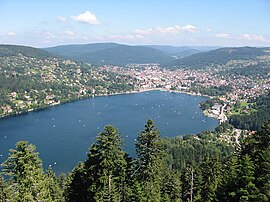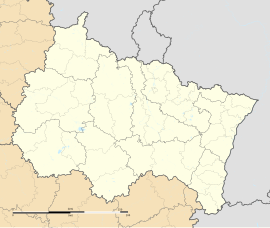Gérardmer
You can help expand this article with text translated from the corresponding article in French. (July 2014) Click [show] for important translation instructions.
|
Gérardmer | |
|---|---|
 Gérardmer and its lake | |
| Coordinates: 48°05′N 6°53′E / 48.08°N 6.88°E | |
| Country | France |
| Region | Grand Est |
| Department | Vosges |
| Arrondissement | Saint-Dié-des-Vosges |
| Canton | Gérardmer |
| Intercommunality | CC Gérardmer Hautes Vosges |
| Government | |
| • Mayor (2020–2026) | Stessy Speissmann[1] |
| Area 1 | 54.78 km2 (21.15 sq mi) |
| Population (2021)[2] | 7,833 |
| • Density | 140/km2 (370/sq mi) |
| Time zone | UTC+01:00 (CET) |
| • Summer (DST) | UTC+02:00 (CEST) |
| INSEE/Postal code | 88196 /88400 |
| Elevation | 584–1,125 m (1,916–3,691 ft) (avg. 670 m or 2,200 ft) |
| Website | mairie-gerardmer.fr |
| 1 French Land Register data, which excludes lakes, ponds, glaciers > 1 km2 (0.386 sq mi or 247 acres) and river estuaries. | |
Gérardmer (French pronunciation: [ʒeʁaʁme] ; German: Gerdsee or archaic Geroldsee, and Giraumoué in local Vosgian) is a commune in the Vosges Department, Grand Est (before 2016: Lorraine), France.
Gérardmer is said to owe its name to Gerard, Duke of Lorraine, who in the 11th century built a tower on the bank of the lake or mer, near which, in 1285, a new town was founded.[3]
Geography
[edit]Gérardmer is situated at a height of 2,200 feet (670 m) at the eastern end of the small lake, the Lac de Gérardmer among forest-clad mountains. Historically it has been the chief summer resort of the French Vosges and was a centre for excursions, including to the summit of the Hohneck and the Schlucht, which is a mountain pass from France to Germany. Nearer the town is the picturesque defile of Granges, watered by the Vologne, which at one point forms the cascade known as the Saut des Cuves.[3]
Population
[edit]| Year | Pop. | ±% p.a. |
|---|---|---|
| 1968 | 9,326 | — |
| 1975 | 9,471 | +0.22% |
| 1982 | 9,106 | −0.56% |
| 1990 | 8,951 | −0.21% |
| 1999 | 8,845 | −0.13% |
| 2007 | 8,738 | −0.15% |
| 2012 | 8,423 | −0.73% |
| 2017 | 7,967 | −1.11% |
| Source: INSEE[4] | ||
Culture
[edit]The Festival international du film fantastique de Gérardmer (literally Gérardmer International Festival of fantastic film, formerly named 'Fantastic'Arts' from 1994 to 2008) is an international festival of horror and fantastic films which has been held each year since 1994 in Gérardmer.
Notable people
[edit]- Maximilien Kelsch (1844–1906), industrialist and politician, born in Gérardmer
- Paul Cuny (1872–1925), industrialist and politician, born in Gérardmer
- Edward Gardère (1909–1997), fencer, born in Gérardmer
- André Gardère (1913–1977), fencer, born in Gérardmer
- Gilberte Cournand (1913–2005), journalist and dance critic, gallery owner and bookseller, born in Gérardmer
- Claude Vanony (1935), storyteller and humorist, born in Gérardmer
- Patrick Rémy (1965), cross-country skier, born in Gérardmer
- Raphaël Dargent (1970), historian, essayist and writer, born in Gérardmer
- Julien Bontemps (1979), sailor, learnt to sail in Gérardmer
- Maxime Laheurte (1985), world nordic combined team champion (2012), born in Gérardmer
- Émile Duguet, Righteous Among the Nations,[5] concealed Jews at his home in Gérardmer[6]
Twin towns
[edit]See also
[edit]References
[edit]- ^ "Répertoire national des élus: les maires". data.gouv.fr, Plateforme ouverte des données publiques françaises (in French). 2 December 2020.
- ^ "Populations légales 2021" (in French). The National Institute of Statistics and Economic Studies. 28 December 2023.
- ^ a b One or more of the preceding sentences incorporates text from a publication now in the public domain: Chisholm, Hugh, ed. (1911). "Gérardmer". Encyclopædia Britannica. Vol. 11 (11th ed.). Cambridge University Press. p. 765.
- ^ Population en historique depuis 1968, INSEE
- ^ Yad Vashem: Righteous Among the Nations Honored by Yad Vashem by 1 January 2016 - FRANCE
- ^ Anonymes, Justes et Persécutés durant la période Nazie dans les communes de France: Émile Duguet (in French)
External links
[edit]- Official website (in French)




